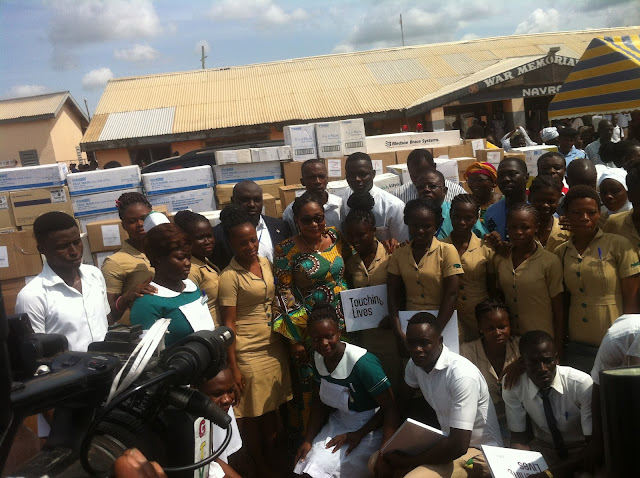The First Lady,
Mrs. Lordina Mahama, says government’s long term vision of providing quality
and accessible health care for all hinges on the collaborative effort of key stakeholders.
She said going forward, the Lordina Foundation is willing to work in tandem with any
organisation whose ideas is routed to supporting the underprivileged have
access to basic health service delivery.
Mrs Lordina Mahama made the
observation at a mini durbar in Navrongo, where she presented large
quantity of medical equipment and supplies to the War Memorial Hospital in
Navrongo to round up the foundation's medical outreach programme dubbed " Preventing Mother -to-Child
Transmission: The key to an HIV free Generation and Keeping Mothers Alive”,
PMTCT.
A similar donation was extended
to the Bolgatanga Regional hospital backed by a free health screening exercise on
syphilis as well as HIV and AIDS.
The Upper East
Region is the last administrative region to benefit from the nationwide medical
outreach and health screening by the First Lady.
The provision of the medical
supplies estimated to cost thousands of cedis is to equip and augment the limited
medical items used by the two major hospitals.
This is expected to translate
into the provision of quality health care to the increasing number of persons that
visits the said facilities.
Among the items received were respirators, plastic
bandages and adhesives, syringes, electrical orthopaedic beds, theatres gloves
and mask including urological products among others.
These were procured by the Foundation in
partnership with a US-based medical group called MEDSHARE.
Presenting her a
keynote address at separate venues, First Lady Mrs Lordina Mahama said her
foundation has not only surpassed its primary objective of addressing the needs
of orphans and the vulnerable in society, but also gone a step further in
serving as advocates for PMTCT and issues regarding reproductive health and
care for persons living with HIV and AIDS especially women.
This, the
foundation considers as a driving force for the realisation of the universal
health coverage as stipulated in the SDGs.
While commending the district for
its contribution to agriculture, Mrs Lordina Mahama said the health of the
people is central to the people is central to governments transformational
agenda and would therefore appreciate the corporation of other institutions in bringing health care to
the doorstep of the poor and the disadvantaged.
The stepped up
campaign geared at improving PMTCT and sexual reproductive health is being implemented
with support from the Organisation of African First Ladies against HIV and AIDS,
OAFLA, the Ghana AIDS Commission and the National AIDS Control Programme.
Among
its key objectives is to galvanize community support and sensitize men to
support their spouses to access PMTCT services.
The First Lady Mrs. Lordina
Mahama said, as President of OAFLA, she was committed to addressing the
critical health needs of women and called for an end to child marriage and
other obnoxious traditional practices that impedes their socio-economic lives of
women.
Speaker after
speaker commended the Lordina Foundation for the benevolence. Receiving the
items, the Regional Director of Health Services, Dr Kofi Issah, hinted that the
facility has 98.5 percent of PMTCT coverage and that out of 12 children born
this year to HIV positive mothers, only one had tested positive to the disease.
He was
however hopeful that with the provision of surgical and anaesthetics, medical
care will be greatly improved.
The First Lady who was bestowed with the royal
name “Awewonno”, meaning God’s Gift,
later presented another set of medical equipment’s to the Bolgatanga Regional
Hospital.
With her were dignitaries including the Upper East Regional Minister,
Albert Abongo and his deputy as well as the Minister of Gender, Children and
Social Protection, Nana Oye Lithur.
GBC













